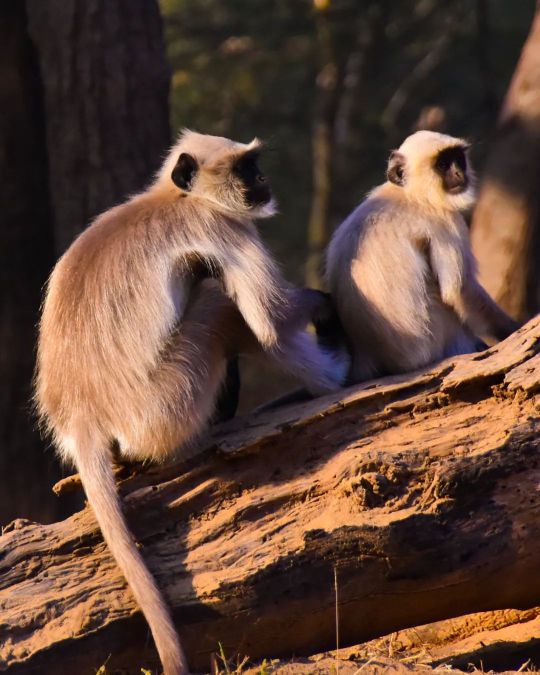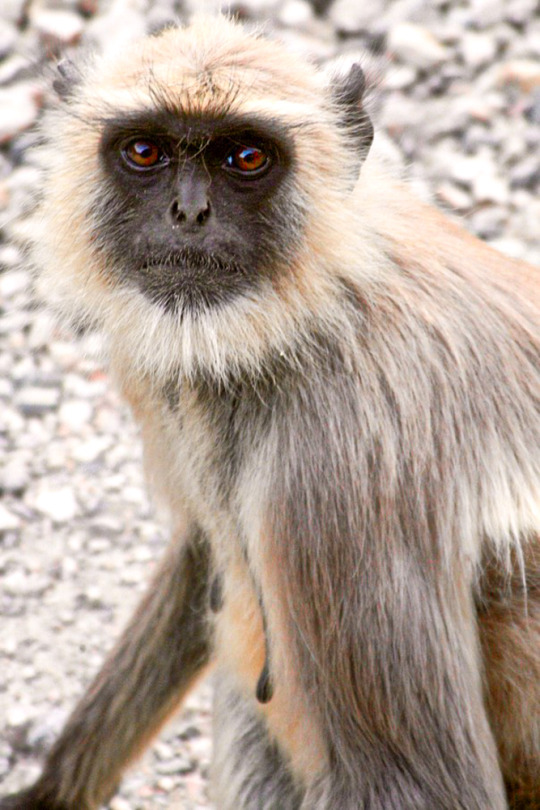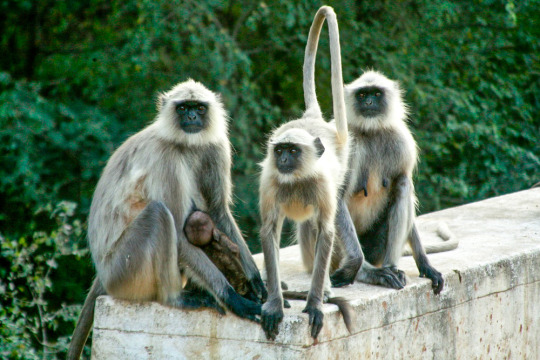#semnopithecus entellus
Text

A cow checks to see if langur monkeys have any interesting food in Pushkar, India - Photograph: Abaca/Rex/Shutterstock
click image link for more Week in Wildlife photos
#india#red kandhari cow#bovidae#bos taurus#langur monkeys#primate#cercopithecidae#presbytini#semnopithecus entellus#wildlife photography
0 notes
Photo

Gray langurs, also called Hanuman langurs and Hanuman monkeys, are Old World monkeys native to the Indian subcontinent constituting the genus Semnopithecus. Traditionally only one species Semnopithecus entellus was recognized, but since about 2001, additional species have been recognized. The taxonomy has been in flux, but currently eight species are recognized. #animalphotos #animalphotography #animalsofinstagram #animalsultans #monkey #discovertheworld #exclusive_animals #explore_wildlife #featured_wildlife #ignature #igscwildlife #live_love_wildlife #marvelshots #marvelouz_animals #naturephotography #naturfotografie #natureisbeautiful #natureshooters #nature_hub #nature_perfection #naturepic #ourplanetdaily #wildlife_inspired #wildlife_seekers #wildlife_shots #wildlifeperfection #wildlifephotographer #wildlifephotography #anshumanpandeyphotography #illuminatingpixels (at Jhalana Reserve Forest) https://www.instagram.com/p/Cp7u6t5rQcY/?igshid=NGJjMDIxMWI=
#animalphotos#animalphotography#animalsofinstagram#animalsultans#monkey#discovertheworld#exclusive_animals#explore_wildlife#featured_wildlife#ignature#igscwildlife#live_love_wildlife#marvelshots#marvelouz_animals#naturephotography#naturfotografie#natureisbeautiful#natureshooters#nature_hub#nature_perfection#naturepic#ourplanetdaily#wildlife_inspired#wildlife_seekers#wildlife_shots#wildlifeperfection#wildlifephotographer#wildlifephotography#anshumanpandeyphotography#illuminatingpixels
6 notes
·
View notes
Text
Mount Abu Wildlife Sanctuary
Flora and Fauna at Mount Abu Wildlife Sanctuary
Mount Abu Wildlife Sanctuary is located in the Aravalli Range in the Sirohi district of Rajasthan, India. It spans an area of 288 square kilometers and is famous for its rich biodiversity. Here is some information about the flora and fauna found in the sanctuary:
Flora:
1. Dry Deciduous Forest: The sanctuary is dominated by dry deciduous forest with a mix of trees, including Dhok (Anogeissus pendula), Khair (Acacia catechu), Salai (Boswellia serrata), and Bamboo (Dendrocalamus strictus).
2. Subtropical Thorn Forest: The lower regions of the sanctuary are covered with subtropical thorn forest, characterized by thorny bushes and shrubs like Cactus, Aerva (Aerva tomentosa), and Zizyphus species.
3. Evergreen Forest: In the valleys and along the streams, there are patches of evergreen forest consisting of trees like Mango (Mangifera indica), Jamun (Syzygium cumini), and Pipal (Ficus religiosa).
4. Medicinal Plants: The sanctuary also houses various medicinal plants, including Aloe vera, Ashwagandha (Withania somnifera), and Brahmi (Bacopa monnieri).
Fauna:
1. Leopard: Mount Abu Wildlife Sanctuary is known for its leopard population. These elusive cats are spotted from time to time in the sanctuary.
2. Sambar Deer: One of the largest deer species found in India, the Sambar (Rusa unicolor) is a common sight in the sanctuary. It is known for its majestic appearance and large antlers.
3. Indian Wild Boar: The sanctuary is also home to the Indian Wild Boar (Sus scrofa), a sturdy and robust animal with characteristic dark bristles on its back.
4. Indian Pangolin: The Indian Pangolin (Manis crassicaudata) is a unique mammal found in the sanctuary. It has a scaly appearance and feeds mainly on ants and termites.
5. Common Langur: The sanctuary is inhabited by the Common Langur (Semnopithecus entellus), a species of monkey. These langurs are known for their gray fur and long tails.
6. Indian Flying Fox: Also known as the Greater Indian Fruit Bat (Pteropus giganteus), the Indian Flying Fox can be found in large numbers in the sanctuary. They are important pollinators and seed dispersers.
7. Various Birds: Mount Abu Wildlife Sanctuary is a paradise for bird enthusiasts. It is home to a variety of bird species, including the Indian Peafowl, Grey Junglefowl, Yellow-footed Green Pigeon, Plum-headed Parakeet, and many more.
These are just a few examples of the flora and fauna found in the Mount Abu Wildlife Sanctuary. The sanctuary's diverse ecosystem supports a range of species, making it a significant conservation area in the region.
How to Reach Mount Abu Wildlife Sanctuary
Reaching the Mount Abu Wildlife Sanctuary is relatively easy, and here is a paragraph on how to get there:
The Mount Abu Wildlife Sanctuary is located in the Aravalli Range of Rajasthan, near the town of Mount Abu. Here are a few ways to reach the sanctuary:
- By Air: The nearest airport to Mount Abu is Udaipur Airport, which is well-connected to major cities in India. From the airport, you can hire a taxi or take a bus to reach the sanctuary, which is approximately 180 kilometers away.
- By Train: The nearest railway station to Mount Abu is Abu Road Railway Station, which is well-connected to major cities like Delhi, Mumbai, and Jaipur. From the railway station, you can hire a taxi or take a local bus to reach the sanctuary, which is around 30 kilometers away.
- By Road: Mount Abu is well-connected by road to major cities in Rajasthan and neighboring states. You can drive to the sanctuary or take a bus from cities like Udaipur, Ahmedabad, and Jaipur. Local buses and taxis are also available from Mount Abu town to reach the sanctuary.
Once you reach Mount Abu, you can hire a local guide or take a safari tour to explore the wildlife sanctuary. It is advisable to check the timings and entry requirements before planning your visit.
If you are looking for visit these places in Mount Abu then, I recommend you the best taxi service in Jodhpur named Jodhpur Cab Service. Jodhpur Cab Service provides there customer best services by their chauffeur.
0 notes
Photo

Northern plains gray langur (Semnopithecus entellus)
The northern plains gray langur is a species of primate in the family Cercopithecidae. Its range covers a large portion of India south of the Himalayas south to the Tapti River and the Krishna River. Its natural habitats are subtropical or tropical dry forests and subtropical or tropical dry shrubland.
photo credits: Rajeev minj
#Northern plains gray langur#Semnopithecus entellus#primate#zoology#biology#biodiversity#science#wildlife#nature#animals#cool critters
161 notes
·
View notes
Photo

Southern plains grey langur (Semnopithecus entellus / Presbytis entellus) tiny juvenile, Jodhpur, Rajasthan India
Photographer: Bernard Castelein
#bernard castelein#photographer#southern plains grey langur#langur#semnopithecus entellus#presbytis entellus#jodhpur#rajasthan#india#nature
5 notes
·
View notes
Photo

GRAY LANGUR or HANUAN LANGUR
Semnopithecus entellus
©Laura Quick
Gray langurs are fairly terrestrial, inhabiting forest, open lightly wooded habitats, and urban areas on the Indian subcontinent. Most species are found at low to moderate altitudes, but the Nepal gray langur and Kashmir gray langur occur up to 4,000 m (13,000 ft) in the Himalayas.
Langurs mostly walk quadrupedally and spend half their time on the ground and the other half in the trees. They will also make bipedal hops, climbing and descending supports with the body upright, and leaps. Langurs can leap 3.6–4.7 m (12–15 ft) horizontally and 10.7–12.2 m (35–40 ft) in descending
In India, gray langurs number at around 300,000. India has laws prohibiting the capturing or killing of langurs, but they are still hunted in some parts of the country. Enforcement of these laws has proven to be difficult and it seems most people are unaware of their protection. Populations are also threatened by mining, forest fires and deforestation for wood.
Other posts:
Capped Langur
François’ langur
Purple Faced Langur

#gray langur#hanuman langur#semnopithecus entellus#©laura quick#asia#india#protected#old world#primates#monkeys#jojowahr#animal#haplorhini#simiiformes#cercopithecidae#colobinae#terrestrial
9 notes
·
View notes
Photo

Gray Langurs Semnopithecus entellus Jojowar, Rajasthan, India 2015 #langurs #semnopithecusentellus #rajasthan #india #jojowar #travelphotography #travel #©lauraquick #southasia #asia https://www.instagram.com/p/BxQOA4DH-BT/?utm_source=ig_tumblr_share&igshid=19ig2xkerlyh2
#langurs#semnopithecusentellus#rajasthan#india#jojowar#travelphotography#travel#©lauraquick#southasia#asia
4 notes
·
View notes
Photo

Gray langur Gray langur, also called Hanuman langur is a genus of Old World monkeys native to the Indian subcontinent. Traditionally only one species Semnopithecus entellus was recognized, but since about 2001, additional species have been recognized. The taxonomy has been in flux, but currently eight species are recognized NIKON D500 F6.0 1/800 s 390.00mm ISO 720 White balance Auto No flash #wildlife #wildlife_perfection #wildlifeonearth #wildlifephotography #wildlifeprotection #wildlifeofinstagram #wildlifeofindia #wildlifeindia #wildlifeaddicts #wildlifeconservation #wildlifeperfection #wildlifefriend #wildlifephotographer #wildlife_aroundworld #wildlife_captures #wildlifeowners #wildlife_inspired #wildlife_photography #wildlife_india #wildlifephoto #wildlife_vision #wildlifelovers #wildlifeart #wildlifephotos #wildlife_in_bl #wildlifeshots #wildlifeartist #wildliferehab #wildliferefuge #wildlifeig (at Nagarahole Tiger Reserve, Karnataka) https://www.instagram.com/p/CBrtnrYHSvP/?igshid=6gyp4r9ssb61
#wildlife#wildlife_perfection#wildlifeonearth#wildlifephotography#wildlifeprotection#wildlifeofinstagram#wildlifeofindia#wildlifeindia#wildlifeaddicts#wildlifeconservation#wildlifeperfection#wildlifefriend#wildlifephotographer#wildlife_aroundworld#wildlife_captures#wildlifeowners#wildlife_inspired#wildlife_photography#wildlife_india#wildlifephoto#wildlife_vision#wildlifelovers#wildlifeart#wildlifephotos#wildlife_in_bl#wildlifeshots#wildlifeartist#wildliferehab#wildliferefuge#wildlifeig
0 notes
Photo

SEMNOPITHECUS ENTELLUS" MONKEY
17 notes
·
View notes
Photo

Wolf-Monkey
Kingdom: Animalia
Phylum: Chordata
Class: Mammalia
Order: Primates
Suborder: Haplorhini
Infraorder: Simiiformes
Parvorder: Catarrhini
Superfamily: Cercopithecoidea
Family: Cercopithecidae
Genus: Canisimias
Species: C. unimetrodon (”wolf-monkey with one type of teeth”)
Ancestral species: Semnopithecus entellus (Northern plains gray langur)
Time period: late Nyctocene to early Solocene (97 million years to 110 million years in the future).
Information: in Solocene Thalassia, it would seem that carnivorous primates are far from an uncommon sight. The Wolf-Monkey is one of these various species. Filling a similar ecological niche to its distant relatives of the genus Necropteryx, the Wolf-Monkey is a wolf-sized carnivore found across the circumpolar regions of the world. They hunt in pack of around 4 other individuals, and each of their teeth have evolved to become sharpened for tearing and gripping. Their fur is brown in the spring and white during the winter, allowing them to blend in with their surroundings. Its hands are noticeably very-large, the reasoning for this being that, when not on the ground, Wolf-Monkeys may seek shelter in the trees, hence their large hands help them to grip onto the tree’s trunk and limbs.
0 notes
Photo

Gray langurs, also called Hanuman langurs and Hanuman monkeys, are Old World monkeys native to the Indian subcontinent constituting the genus Semnopithecus. Traditionally only one species Semnopithecus entellus was recognized, but since about 2001, additional species have been recognized. The taxonomy has been in flux, but currently eight species are recognized. #animalphotos #animalphotography #animalsofinstagram #animalsultans #monkey #discovertheworld #exclusive_animals #explore_wildlife #featured_wildlife #ignature #igscwildlife #live_love_wildlife #marvelshots #marvelouz_animals #naturephotography #naturfotografie #natureisbeautiful #natureshooters #nature_hub #nature_perfection #naturepic #ourplanetdaily #wildlife_inspired #wildlife_seekers #wildlife_shots #wildlifeperfection #wildlifephotographer #wildlifephotography #anshumanpandeyphotography #illuminatingpixels (at Jhalana Reserve Forest) https://www.instagram.com/p/CouspjDL_EV/?igshid=NGJjMDIxMWI=
#animalphotos#animalphotography#animalsofinstagram#animalsultans#monkey#discovertheworld#exclusive_animals#explore_wildlife#featured_wildlife#ignature#igscwildlife#live_love_wildlife#marvelshots#marvelouz_animals#naturephotography#naturfotografie#natureisbeautiful#natureshooters#nature_hub#nature_perfection#naturepic#ourplanetdaily#wildlife_inspired#wildlife_seekers#wildlife_shots#wildlifeperfection#wildlifephotographer#wildlifephotography#anshumanpandeyphotography#illuminatingpixels
0 notes
Photo

🐵😊🌳❣ Gray langurs or Hanuman langurs, the most widespread langurs of the Indian Subcontinent, are a group of Old World monkeys constituting the entirety of the genus Semnopithecus (from Ancient Greek σεμνός semnós, “revered, august, holy”, and πίθηκος píthēkos, “ape, monkey”). All taxahave traditionally been placed in the single species Semnopithecus entellus.🐵🐒 In 2001, it was recommended that several distinctive former subspecies should be given speciesstatus, so that seven species are recognized.A taxonomic classification with fewer species has also been proposed.Genetic evidence suggests that the Nilgiri langur and purple-faced langur, which usually are placed in the genus Trachypithecus, actually belong in Semnopithecus.Gray langurs are large and🗻 fairly terrestrial, inhabiting forest, open lightly wooded habitats, and urban areas on the Indian subcontinent. Most species are found at low to moderate altitudes, but the Nepal gray langur and Kashmir gray❣ langur occur up to 4,000 metres (13,000 ft) in the Himalayas.🌳 🗻🏕🌏🐒 #himachalwildlifepicture #chamba #likeforfollow #Langur #indianlangur #Animals #monkey #graylangurs #wildlifephotography #hanuman #wildlifeindia #animalsworld #natgeo #himachalpictures 🐒🐵🐵🐵😍😍 #birdsofhimachal #himachalwildlife #northindiawildlife #himachalanimals #himachalpradesh #wildlife #animalslover #animal #wildernessculture #india #indiawildlife #photooftheday #naturelover #india_gram #family #hanumanlangur (at Chamba City, Himachal Pradesh, India) https://www.instagram.com/p/ByhFVMMpcv4/?igshid=1imes6t8icys4
#himachalwildlifepicture#chamba#likeforfollow#langur#indianlangur#animals#monkey#graylangurs#wildlifephotography#hanuman#wildlifeindia#animalsworld#natgeo#himachalpictures#birdsofhimachal#himachalwildlife#northindiawildlife#himachalanimals#himachalpradesh#wildlife#animalslover#animal#wildernessculture#india#indiawildlife#photooftheday#naturelover#india_gram#family#hanumanlangur
0 notes
Photo

Un homme donne des biscuits à des singes Langurs Semnopithecus entellus), on les appelle également Entelle des Indes, Langur sacré, Entelle d'Hanuman. Les Hindous les vénèrent comme représentants du dieu-singe Hanuman, dont l'armée simiesque participa au sauvetage de Sītā, l'épouse du dieu Rāma qui avait été kidnappée par le roi des démons, selon l'épopée du Ramayana. Dans certaines villes, comme Delhi par exemple, ces langurs sont dressés pour éloigner les macaques qui s'enfuient dès qu'ils les aperçoivent. Ici ce ne sont que des femelles avec leur petit accroché à leur ventre.
********************
A man gives biscuits to Langurs monkeys (Semnopithecus entellus), They are also called the northern plains gray langur, the Sacred Langur, the Hanuman Langurs. The Hindus worshiped them as representatives of the monkey god Hanuman, whose simian army participated in the rescue of Sītā, the wife of the god Rāma who had been kidnapped by the king of demons, according to the Ramayana epic. In some cities, like Delhi, for example, these langurs are trained to keep macaques away as soon as they see them. Here they are only females with their little hooked to their belly.
15 notes
·
View notes
Photo

Southern plains grey langur ( Semnopithecus entellus / Presbytis entellus) close up face profile, Sawai Modhopur, Rajasthan, India
Photographer: Bernard Castelein
#bernard castelein#photographer#southern plains grey langur#langur#semnopithecus entellus#presbytis entellus#sawai modhopur#rajasthan#india#nature
3 notes
·
View notes
Text
A Peek from behind the Branches… Photo by Arjun R Krishna — National Geographic Your Shot
Shot Captured from Nagarjuna Sagar Tiger Reserve in Dec 2017. Its a Hanuman Langur /Semnopithecus entellus/ peeking from behind the branches seeing us. These langurs are largely gray (some more yellowish), with a black face and ears. Externally, the various species mainly differ in the darkness of the hands and feet. Nagarjunsagar-Srisailam Tiger Reserve is […]
A Peek from behind the Branches……
View On WordPress
0 notes
Text
Hulmánnal gyarapadott a Nyíregyházi Állatpark
Hulmánnal gyarapadott a Nyíregyházi Állatpark
Nőstény hulmán (Semnopithecus entellus) érkezett a Nyíregyházi Állatparkba.
(more…)
View On WordPress
0 notes